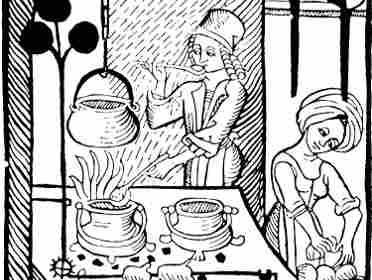Medieval Food

Foods Eaten by Serfs in the Middle Ages
Food was an obsession for all classes of medieval society but the types of food that were eaten in the Middle Ages primarily depended on an individual’s social rank. The serfs who were at the bottom of the medieval social hierarchy predominantly ate gruel and porridge along vegetables that were available at a particular region and season of the year – cabbage, beets, legumes, carrots, onion, etc. Cereals were the main ingredients of the majority of medieval meals, while bread became one of the basic foods only in the 12th and 13th centuries.
Foods Eaten by Medieval Nobility and Clergy
Medieval social elites – nobility and clergy ate more diversified foods than the serfs. Many types foods were considered luxurious goods and were very expensive, while some types of foods such as game was an exclusive privilege of nobility. The nobles in the Middle Ages also viewed food as a status symbol.
Medieval Banquets
Medieval banquets are the best evidence for the role of food as a status symbol in the Middle Ages. They were characterized gluttonous eating and drinking but there was a major difference between those that were organized by nobles of higher social rank and petty nobles. The social status of the host was revealed by both quantity and exclusivity of foods that were served, while the served foods also revealed the social rank of the invited guests. Those who were lower in the social hierarchy were served with fewer and less prestigious foods.
Meat in the Middle Ages
Meat was considered prestigious by all classes of feudal society in the Middle Ages. Pork was the most commonly eaten meat by both serfs and nobility. Relatively common were also chicken and lamb, while fish was viewed as an alternative to meat and was usually eaten on fast days. Beef was not as common as today, while cows and oxen were in first place valued as working animals and for milk production.
Fruits in Medieval Europe
Both fresh and dried fruits were popular during the Middle Ages and were also used as sweeteners. Honey and sugar were too expensive for the majority of medieval population. Mediterranean fruits such as oranges, pomegranates, grapes, figs and dates were highly valued throughout medieval Europe but were considered luxurious goods in Central and Northern Europe.
Medieval Drinks
All medieval social classes preferred alcohol over other types of beverages. Wine was very popular all over Europe but it was unaffordable for the majority of people outside the Mediterranean where either beer or ale was drunk.




